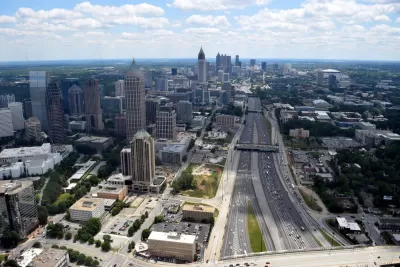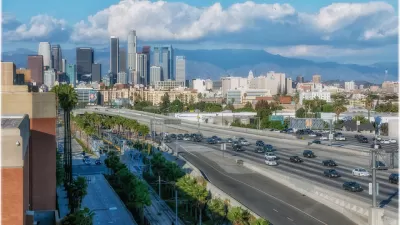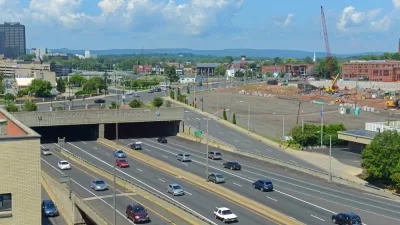A thorough and damning indictment of 20th century land use and infrastructure planning, and its contemporary legacy of segregation and congestion.

Kevin M. Kruse starts a big feature on the segregationist purposes of 20th century urban freeway planning by noting the terrible traffic conditions in Atlanta. The traffic is a result of the deliberate design of a system meant to segregate white populations from black, according to Kruse.
"In Atlanta, as in dozens of cities across America, daily congestion is a direct consequence of a century-long effort to segregate the races."
While the federal government paid for most of the creation of the Interstate highway system during the 1950s and 1960s, local officials had a lot of power in determining the path of urban freeways.
"As in most American cities in the decades after the Second World War, the new highways in Atlanta — local expressways at first, then Interstates — were steered along routes that bulldozed 'blighted' neighborhoods that housed its poorest residents, almost always racial minorities," according to Kruse. The story is repeated in other cities like Jacksonville, Miami, Nashville, New Orleans, Richmond, and Tampa, but also other cities around the country, like Chicago, Cincinnati, Denver, Detroit, Indianapolis, Los Angeles, Milwaukee, Pittsburgh, St. Louis, Syracuse, and Washington.
Interstates were a tool of urban renewal, destroying black and low-income neighborhoods, but also as a toll of segregation. Kruse explains:
"Today, major roads and highways serve as stark dividing lines between black and white sections in cities like Buffalo, Hartford, Kansas City, Milwaukee, Pittsburgh and St. Louis. In Atlanta, the intent to segregate was crystal clear. Interstate 20, the east-west corridor that connects with I-75 and I-85 in Atlanta’s center, was deliberately plotted along a winding route in the late 1950s to serve, in the words of Mayor Bill Hartsfield, as “the boundary between the white and Negro communities” on the west side of town."
The story told by Kruse continues, with worsening congestion in the Atlanta region and the obstinate opposition of white suburban neighborhoods to public transit. That part of story continues to this day, as Gwinnett County voted MARTA funding down yet again earlier this year.
FULL STORY: What does a traffic jam in Atlanta have to do with segregation? Quite a lot.

Study: Maui’s Plan to Convert Vacation Rentals to Long-Term Housing Could Cause Nearly $1 Billion Economic Loss
The plan would reduce visitor accommodation by 25,% resulting in 1,900 jobs lost.

North Texas Transit Leaders Tout Benefits of TOD for Growing Region
At a summit focused on transit-oriented development, policymakers discussed how North Texas’ expanded light rail system can serve as a tool for economic growth.

Why Should We Subsidize Public Transportation?
Many public transit agencies face financial stress due to rising costs, declining fare revenue, and declining subsidies. Transit advocates must provide a strong business case for increasing public transit funding.

How to Make US Trains Faster
Changes to boarding platforms and a switch to electric trains could improve U.S. passenger rail service without the added cost of high-speed rail.

Columbia’s Revitalized ‘Loop’ Is a Hub for Local Entrepreneurs
A focus on small businesses is helping a commercial corridor in Columbia, Missouri thrive.

Invasive Insect Threatens Minnesota’s Ash Forests
The Emerald Ash Borer is a rapidly spreading invasive pest threatening Minnesota’s ash trees, and homeowners are encouraged to plant diverse replacement species, avoid moving ash firewood, and monitor for signs of infestation.
Urban Design for Planners 1: Software Tools
This six-course series explores essential urban design concepts using open source software and equips planners with the tools they need to participate fully in the urban design process.
Planning for Universal Design
Learn the tools for implementing Universal Design in planning regulations.
City of Santa Clarita
Ascent Environmental
Institute for Housing and Urban Development Studies (IHS)
City of Grandview
Harvard GSD Executive Education
Toledo-Lucas County Plan Commissions
Salt Lake City
NYU Wagner Graduate School of Public Service





























